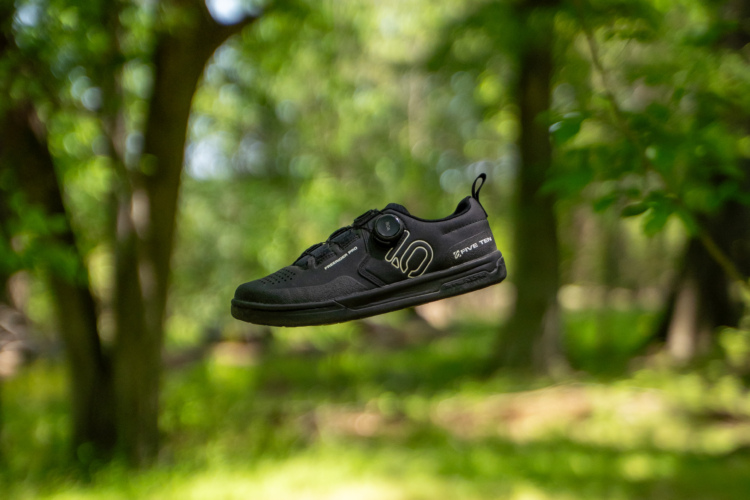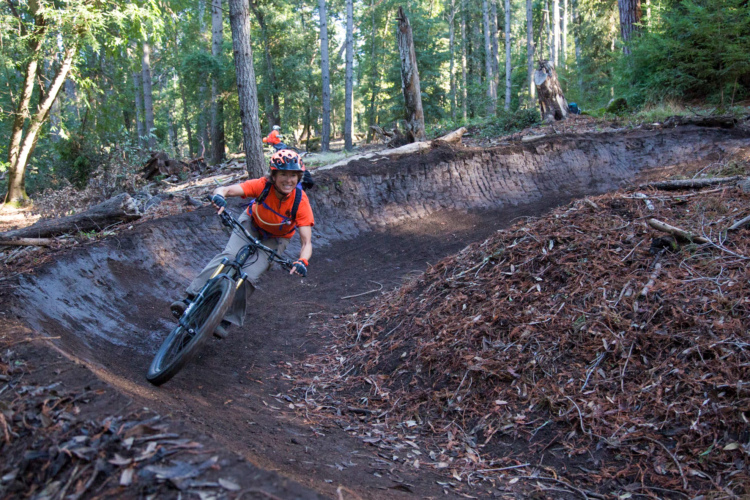
Brakes are arguably one of the most important components on modern bikes, with manufacturers constantly finding ways to increase usable power while conserving modulation and keeping the system consistent in different weather and temperature conditions. The Hope brand has been making CNC-machined stoppers in England since 1989, and the Hope XCR Pro E4 brake set on test here combines their Cross-Country oriented “XCR” lever with their dedicated enduro “E4” four-piston caliper. The result: a brake aimed at the growing trail/downcountry segment.
Hope XCR Pro E4 brakes key specs
- Four pistons
- DOT 5.1 brake fluid
- Carbon blade and titanium hardware
- One piece caliper
- Available in seven colors
- Weight: 236g per brake (claimed) not including fluid
- Price: $285
- Buy from Hope
Starting with the lever, Hope designed the XCR lever with simplicity and weight savings in mind. It features the usual CNC body construction, a carbon fiber lever blade, and titanium hardware. This combination of materials paired with the anodized body contributes to the unique look of the lever. Like a motorcycle brake, the lever has an open bath reservoir, which tops up the fluid in the lines as the brake pads wear out. Theoretically, this helps maintain consistent pressure in the hydraulic system, reducing brake fade as the pads wear out. The lever blade reach is adjustable with an hex key, which is a bonus. Unfortunately, there is no bite point or contact adjustment on the lever. However, the lever feel remained reasonably consistent throughout my test.
This Hope XCR Pro E4 brake set combines the lightweight construction of the XCR lever with the power and modulation of the updated E4 caliper. This four-piston caliper was originally introduced to the market with the now-discontinued Tech 3 lineup. The E stands for “enduro,” while the number four refers to the four, 16mm stainless-steel pistons that push on a decently sized brake pad. With a similar pad surface area to a SRAM Code or Shimano D-Type pad, these are slightly more square-looking and have two extended edges per side that help reduce rattle when plowing through rough terrain. Although not recommended, pads can be installed on the caliper with the wheels on the bike and are held by a hex bolt with a cotter pin on the end. This brake configuration is only available with a standard 5mm black Hope hose (some models have a silver braided hose option).

Installation and set up
The Hope XCR Pro E4 brakes came pre-bled. However, I had to go through the entire bleed process on both brakes as the set came set up in a moto-style configuration. I also had to route the rear brake hose through my new Rocky Mountain Element carbon frame. I used Hope’s “Easy” bleed kit and Maxima DOT 5.1 brake fluid for the installation. I also watched Hope’s video tutorial to eliminate any guesswork. The bleed process was quick and straightforward (similar to a Shimano system). After my first attempt, the levers felt firm and consistent and required no re-bleeding. One thing to note is Hope’s barb and olive use a third piece in the form of a copper washer (provided in the brake set). After going through Hope’s Disc Brake Guide, I opted for their standard six-bolt floating rotors in the recommended 180 mm diameter. I also chose to install the green organic brake pads, which provided a nice sharp bite after a short break-in period. I adjusted the reach to what felt good and had some positive first impressions in the parking lot. The lever feel isn’t as light as a Shimano or Hayes Dominion, but it feels intuitive and inspires confidence to try some endos and trackstands.

On the trail
The first few laps on these brakes featured some classic BC cross-country style trails; janky, tight, and loose. I rode some of my favorite trails at the Hartland Mountain Bike Park (one of the BC Bike race venues). The brakes felt progressive, with lots of modulation before the tires locked up. This wide range of modulation proved useful when riding the steep rock faces and slow-speed, janky sections of my local trails.
It took me a few rides to adjust my braking on steeper, higher-speed trails; I always had plenty of braking power, it was just a matter of adapting to the wide range of control as opposed to the on/off feel of my previous setup. After the first few rides, I found myself doing a minor reach and angle adjustment on the levers. The more I rode the brakes, the more I enjoyed them, and the way the power was delivered was adequate for the tires I used. I went through three tires during the test; I started with the stock Maxxis Rekon EXOs, switched to Maxxis Forekaster II EXO+, and finalized the test with the more aggressive Continental Xynotal enduro casing tires. I wanted to keep things light and fast-rolling, sticking to the “downcountry” theme.

Share your Hope XCR Pro brakes review
Throughout the summer I put more and more kilometers on the brakes and ended up replacing the rear brake pads at nearly 750 km with a little life left. Ahead of a trip to Whistler I replaced the pads with original Hope sintered pads to ensure I had enough pad life for the long weekend. The ultimate test for these brakes was a 13.5-hour trail ride in the Whistler Valley, with a total elevation drop of 4,269 meters (14000ft+) of technical singletrack. The brakes were consistent during the ride, with no unusual inconsistencies or sponginess. In reality, most brake pads will eventually glaze and make noise after a few hours of technical, uninterrupted descending. However, I was impressed with how well the Hope XCR Pro E4 brakes handled heat and kept a consistent bite point during the endless descents.

My only complaint was the noise from the rotors during a long descent. This is most likely the “floating” construction of the rotors oscillating as the temperatures rise. I could hear a minor ticking noise, and it only happened on descents longer than 15 minutes when I was constantly on the brakes. The difference in bite between the metallic and organic pads is noticeable, with the sintered pads performing slightly more consistently on long, continuous descents (as expected). The brakes never pulled to the bar, and although there were long descents where the bite point wandered slightly, it was always in the ballpark and remained consistent without the need for bleeding or adjusting the reach setting. Even after 1000 km of riding in BC.


Pros and cons of Hope XCR Pro brakes
Pros
- Great modulation and usable power.
- Lightweight construction.
- Available in different colors.
- Easy to service.
Cons
- Lack of bite point adjustment on the lever.
- Floating rotors can be noisy on continuous, long descents.
- Lever feel is not the lightest in the market.
Bottom line
For the weight-conscious trail rider or aggressive XC racer looking for a good-looking set of CNC machined disc brakes, I would highly recommend the Hope XCR Pro E4 brakes. They are by no means a downhill brake, but they have enough power and consistency to go party if you want to. They also pair well with modern XC and trail tires, minimizing unwanted skidding with extra modulation.




















0 Comments